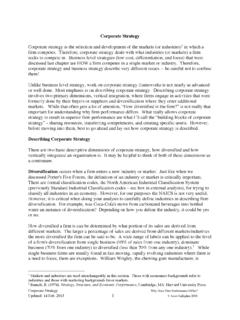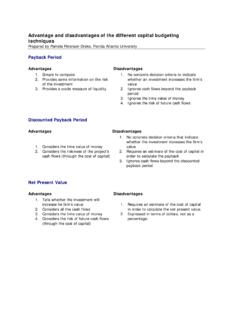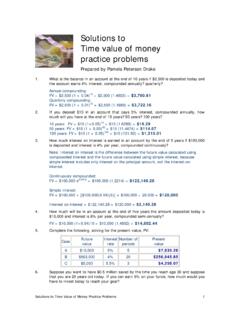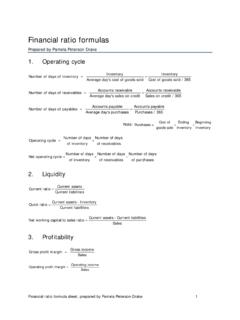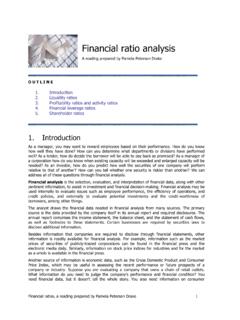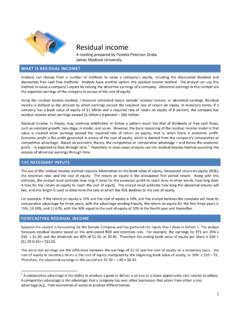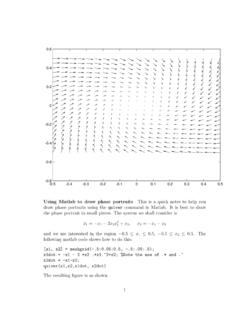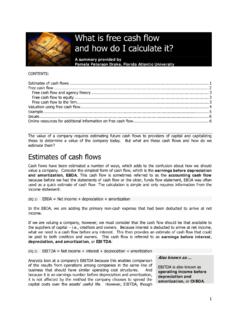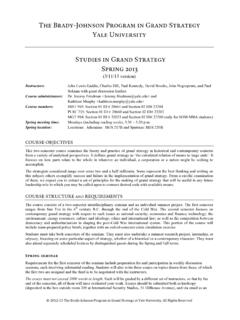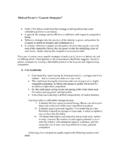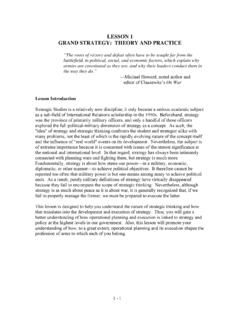Transcription of Business Unit Strategies - educ.jmu.edu
1 Business Level Strategies Why Does Firm Performance Differ? Updated: 17 Sept 2008 1 Scott Gallagher 2004 Business Level Strategies So far we have talked about three basic reasons why firm performance differs. We have talked about mission and goals, the external environment, especially the industry environment, and about VRIO firm resources. This chapter discusses the last piece of the puzzle, how do firms develop and deploy their resources given the external environment in any one particular market or industry? In answering this question we'll describe three generic Strategies . Three generic ways to describe a firms Business level strategy are low cost, differentiation, and focus.
2 There are OTHER sets of generic Strategies (see ___) but these are the three simplest. These three can also be further subdivided. However, given the trouble companies have just getting one of these three basic ones right, we'll keep our focus here and return to some finer distinctions in the last chapter. Keep in mind these are broad ways to think about how you are competing against your rivals in a single market or industry. The low cost strategy emphasizes having the lowest costs, not necessarily the lowest price, in a market. A firm attempting to realize a low cost strategy should stress resources that facilitate efficiency. A firm that has successfully achieved a low cost position will have the lowest costs relative to competitors.
3 A firm can use such a position to either lower its prices and gain market share and sales from rivals OR keep its prices at the present market level and make relatively more profit per unit sold. The key idea is that cost and price are independent choices, and this strategy is focused on cost. The differentiation strategy focuses on developing a unique product or (equally useful) a perception of a unique product that customers are willing to pay a premium for. If a firm is not receiving a premium price for its goods or services it is NOT a differentiator. A firm seeking to follow a differentiation strategy should attempt to develop and enhance its resources that promote customer responsiveness, quality, and/or innovation.
4 Note that costs are still important to a differentiator because it is possible that the costs of making the product unique will be greater than the premium consumers are willing to pay for it. There is a third strategy called focus. A firm attempting to implement a focus strategy is serving the needs of a limited group or segment very well. Often times this is a remainder category for firms that clearly don't have a cost advantage of some type nor receive a premium price for their product. A firm with a focus strategy must carefully consider its target market and what they desire. These three generic Strategies were popularized by Michael Porter back in 1980. Shortly thereafter he made a video about them and highlighted Ivory soap as an example of low cost, American Airlines as a differentiator, and Cray Computer as a focuser.
5 The fact that American Airlines has faced considerable difficulty and that Cray is no longer with us highlights how precarious any firm is in a competitive environment. Finally, there is a fourth result that is not really a strategy but is helpful to view as one, stuck in the middle. A firm that is stuck in the middle is not succeeding in any one of the three Strategies Business Level Strategies Why Does Firm Performance Differ? Updated: 17 Sept 2008 2 Scott Gallagher 2004 very well. As a result, it usually loses out to successful differentiators and low cost firms. Getting suck in the middle is easy to do and it frequently occurs because a firm tries to switch between Strategies or be both low cost and differentiate.
6 Needless to say, being stuck in the middle is a bad thing. As you can see, based on this framework, all firms have at least one Business level strategy. Firm which are in multiple industries can have different Business level Strategies in each of their different markets. However, ALL firms have a Business level strategy wither they intend it or not. If you ask a Business executive what their strategy is and they say something like make money you can translate that as soon to be stuck in the middle. Alignment. None of the three Business level strategy is inherently better than the others. Successful firms have embodied each of them. The primary issue of concern for performance is therefore not which strategy the firm has taken but how well the firm has aligned its resources and capabilities on that strategy.
7 Therefore, the key is not which strategy but how well the firm is ALIGNED on it. Alignment is simply defined as how well each aspect of the firm supports its Business level strategy. So while Business level Strategies can be described in three ways they are conceptually evaluated based on alignment. In order to examine the importance of alignment in more detail we'll look at each of the Strategies and how they are determined. Cost Leadership. A cost leader is producing at an industry's lowest costs. Recall that efficiency is defined as output divided by input. Therefore, such a firm often strives to produce at large volumes to take advantage of economies of scale.
8 It does this by targeting the average consumer knowing that while the product may not be exactly what each consumer wants, it has broad enough appeal to create demand for a large volume production. With is standardized stores and similar product mix, Wal-Mart is the epitome of a cost leader. Efficiency provides the foundation for the cost leadership strategy. Efficiency is commonly obtained from each of the functional areas, economies of scale, and learning effects. Each functional area of the firm ( marketing, production, etc.) is a potential source of efficiency. Does each one strive to reward more efficient production or the targeting of the largest market?
9 Probably one of the most over looked functions is human resources, a quick check to see if a firm's incentive systems are in alignment with its strategy often proves quite insightful. If economies of scale, unit cost reductions as output expands, are present then there are opportunities for cost leadership to be especially effective. Similarly with learning effects, which represent cost savings from learning by doing. These also reduce costs, and unlike economies of scale, are often highly visible in service industries. For example H&R Block's tax preparers reap considerable learning economies from doing so many tax returns. Some people confuse learning effects, which are real, with something that looks and sounds similar but is actually very different - the experience curve.
10 Probably no other strategy concept is more misused and misapplied than the experience curve. When first developed by the Boston Consulting Group, the experience curve was nothing more than an observed decline in unit costs over the life of a product. Therefore, it was an INDUSTRY not a FIRM measure. Some people discuss the experience curve when they mean the learning curve - which is simply the graphical illustration of the marginal gains from learning by doing - and vice versa. Therefore, you must Business Level Strategies Why Does Firm Performance Differ? Updated: 17 Sept 2008 3 Scott Gallagher 2004 be careful and check the axis of the graphs as they are two very different ideas.
